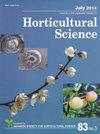Effects of Blanching Method on Sugar and Protodioscin Contents of White Asparagus Spears
Journal of The Japanese Society for Horticultural Science
Pub Date : 2012-04-01
DOI:10.2503/JJSHS1.81.166
引用次数: 11
Abstract
In Japan, white asparagus spears are grown using two blanching methods to block sunlight: the traditional soil-mound and the film-cover methods. The objective of this study was to investigate the influence of the film-cover and soil-mound methods on components of white asparagus spears related to flavor, especially sweetness and bitterness. We investigated the effects of the two blanching methods on sugar (fructose, glucose, and sucrose) and protodioscin (a major furostanol saponin in white spears) contents in white spears by conducting a spring field survey and an experiment using winter-forcing cultures. No significant differences were observed in sugar content or composition in spears cultivated by the two methods in either the field survey or the experiment. Protodioscin content tended to be higher in spears blanched by the soil-mound method than in spears blanched by the film-cover method in both the field survey and the experiment. These results suggest that differences in the flavor of white spears grown using the two blanching methods are caused mainly by bitterness associated with saponin content, and saponin content may be influenced by soil-borne stresses.烫烫方式对白芦笋笋糖和原薯蓣皂苷含量的影响
在日本,种植白芦笋的方法有两种,一种是传统的土堆法,另一种是覆膜法。本研究旨在探讨覆膜和土堆处理对白芦笋茎中与风味有关的成分,尤其是甜度和苦味的影响。通过春季田间调查和冬令培养试验,研究了两种烫烫方式对白苗中糖(果糖、葡萄糖和蔗糖)和原薯蓣皂苷(白苗中主要的糠醇类皂苷)含量的影响。在田间调查和试验中,两种方法栽培的矛的含糖量和组成均无显著差异。田间调查和试验结果表明,土堆法漂烫的矛中原薯蓣皂苷含量高于覆膜法漂烫的矛。上述结果表明,两种漂烫方式所产生的白苗风味差异主要是由与皂苷含量相关的苦味引起的,而皂苷含量可能受土壤胁迫的影响。
本文章由计算机程序翻译,如有差异,请以英文原文为准。
求助全文
约1分钟内获得全文
求助全文
来源期刊
自引率
0.00%
发文量
0
审稿时长
>36 weeks

 求助内容:
求助内容: 应助结果提醒方式:
应助结果提醒方式:


